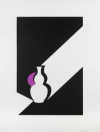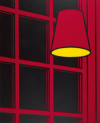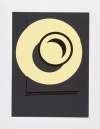Some
Poems of Jules Laforgue
Patrick Caulfield's Some Poems Of Jules Laforgue melds visual art with poetic nuance in this emotive series of silkscreen prints. Created in 1973, the series fosters a visual dialogue on love, longing, and existentialism, utilising abstract shapes and commonplace items as vehicles of expression.
Patrick Caulfield Some Poems of Jules Laforgue For sale
Some Poems of Jules Laforgue Value (5 Years)
With £4520 in the past 12 months, Patrick Caulfield's Some Poems of Jules Laforgue series is one of the most actively traded in the market. Prices have varied significantly – from £85 to £1344 – driven by fluctuations in factors like condition, provenance, and market timing. Over the past 12 months, the average selling price was £565, with an average annual growth rate of 2.18% across the series.
Some Poems of Jules Laforgue Market value
Auction Results
| Artwork | Auction Date | Auction House | Return to Seller | Hammer Price | Buyer Paid |
|---|---|---|---|---|---|
 Ah Storm Clouds Rushed From The Channel Coasts (Some Poems Of Jules Laforgue; Edition B) Patrick Caulfield Signed Print | 22 Jun 2023 | Forum Auctions London | £595 | £700 | £900 |
 And I Am Alone In My House (Some Poems Of Jules Laforgue; Edition B) Patrick Caulfield Signed Print | 22 Jun 2023 | Forum Auctions London | £595 | £700 | £900 |
 She Fled Along The Avenue (from Some Poems By Jules Laforgue; Edition B) Patrick Caulfield Signed Print | 10 May 2023 | Tate Ward Auctions | £425 | £500 | £700 |
 Curtains Drawn Back From Balconies Of Shores (from Some Poems of Jules Laforgue; Edition C) Patrick Caulfield Signed Print | 5 Dec 2018 | Bonhams Knightsbridge | £468 | £550 | £700 |
 All These Confessions (Some Poems Of Jules Laforgue; Edition B) Patrick Caulfield Signed Print | 5 Dec 2017 | Forum Auctions London | £765 | £900 | £1,150 |
Ah! This Life Is So Everyday (Some Poems Of Jules Laforgue; Edition B) | 22 Mar 2017 | Bonhams Knightsbridge | £425 | £500 | £600 |
Sell Your Art
with Us
with Us
Join Our Network of Collectors. Buy, Sell and Track Demand
Meaning & Analysis
Patrick Caulfield's Some Poems Of Jules Laforgue merges visual art with poetry to create a series that resonates with emotional and existential themes. Each print in the series transforms the mundane into the extraordinary, using objects like glassware, furniture, and interior spaces as poignant symbols. These items, often overlooked in their everyday contexts, are depicted in bold colours against stark backgrounds, presenting them as sites of narrative and emotion.
The titles of the prints, directly drawn from Laforgue’s poetry, guide the viewer into the artwork’s intended emotional or philosophical exploration. For instance, the print My God! My God! Will She Relent? features a stark depiction of a clock, the simplicity of which belies the complex emotions of waiting and longing for love, suggestive of the complex relationship between the passage of time and anticipation.
This series is notable for its ability to create a dialogue between the visual and the verbal, where each piece stands as an interpretation of Laforgue’s poetry but also as an independent exploration of universal themes such as loneliness, longing, and the human condition. Caulfield's work in this series showcases his evolution as an artist who depicts physical spaces and delves into the emotional and existential spaces they represent.







